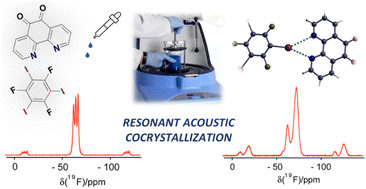Halogen-bonded cocrystals via resonant acoustic mixing†
Abstract
Resonant acoustic mixing is a relatively gentle mechanochemical technology that employs pressure waves to induce chemical and morphological transformations. We report here on the production of eleven halogen-bonded (XB) cocrystalline architectures via neat and liquid-assisted resonant acoustic mixing (RAM). Two strong iodinated XB donors, namely 1,4-diiodotetrafluorobenzene (p-DITFB, 1) and 1,3,5-trifluoro-2,4,6-triiodobenzene (sym-TFTIB, 2) each react with five XB donors, namely 2,3,5,6-tetramethylpyrazine (TMP, a), 4-dimethylaminopyridine (DMAP, b), 1,10-phenanthroline (o-Ph, c), 1,10-phenanthroline-5,6-dione (PheDON, d), and 4,5-diazafluoren-9-one (DIZFON, e) to form ten cocrystals. For these systems, it is shown that RAM is capable of producing the same products as are obtained via ball milling. Two novel cocrystals are obtained (of 2d featuring bifurcated XBs, and 2e featuring monofurcated XBs) and their single-crystal X-ray structures are reported. However, an eleventh stoichiomorphic cocrystal of p-DITFB and TMP is obtained exclusively via RAM, suggesting that the combination of RAM and milling approaches may afford a broader exploration of the polymorphic and stoichiomorphic landscape than the use of a single technique in isolation. All products are characterized via powder X-ray diffraction, and 13C cross-polarization magic angle spinning (CP/MAS) and 19F MAS NMR spectroscopy, providing further evidence for the phase purity of samples obtained from RAM experiments and for the degree of polymorphic control available when small volumes of liquid are employed in mechanochemical reactions. This work demonstrates the potential of RAM for the production of known and novel halogen-bonded cocrystalline assemblies, including polymorphic and stoichiomorphic structures.



 Please wait while we load your content...
Please wait while we load your content...